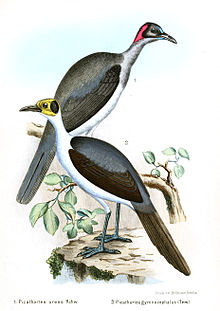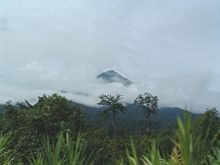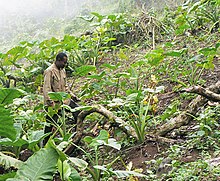Grey-necked rockfowl
| Grey-necked rockfowl | |
|---|---|

| |
| Illustration grey-necked (background) with white-necked (foreground) rockfowl | |
| Scientific classification | |
| Domain: | Eukaryota |
| Kingdom: | Animalia |
| Phylum: | Chordata |
| Class: | Aves |
| Order: | Passeriformes |
| Infraorder: | Passerides
|
| Family: | Picathartidae |
| Genus: | Picathartes |
| Species: | P. oreas
|
| Binomial name | |
| Picathartes oreas Reichenow, 1899
| |

| |
| The distribution of the grey-necked rockfowl (green) | |
The grey-necked rockfowl (Picathartes oreas) is a medium-sized
This rockfowl feeds primarily on insects, though some plant matter, such as fruit and flower buds, is eaten. One feeding strategy involves following
This species is classified as
Taxonomy
This species was first
This species has numerous common names, including the grey-necked rockfowl, grey-necked picathartes, bare-headed rockfowl, red-headed rockfowl, blue-headed picathartes, and grey-necked bald crow.[12][13][14] Rockfowl is a reference to the species' habit of building mud nests on rock surfaces and caves.[15] Picathartes refers to the species' scientific name.[6] Bald crow is a reference to its featherless head and somewhat crow-like appearance, especially in its beak.[16]
Description
This rockfowl measures approximately 33 to 38 centimetres (13 to 15 in) in length, with its notably long tail contributing about 14 centimetres (5.5 in).
The nestling is born nearly featherless except for tiny primary quills and a fine down along its spine, humerus, forearm, and femur.[17] Its skin is dark pink but displays variable black patches on its upperside.[17] The gape is yellow.[17] As the nestling develops, its plumage begins to resemble that of the adult, though it has white flecks on its wing coverts and the featherless skin on the head is black or dark brown, not powder blue, on the forecrown and dark reddish brown, not carmine, on the hindcrown.[17] After fledging, the immature closely resembles the adult except for the bare patch on the back of the head being golden yellow instead of carmine and the tail being only a third as long as that of an adult.[20]
The grey-necked rockfowl is a relatively silent species.[17] It has been known to give a quiet, one to two second long, hissing "wheet" call several times at intervals of about four seconds.[17] To give this call, the rockfowl opens its beak and inflates its throat.[17] When bringing food to their nests, the adults give one or two "peep"s.[17] After reaching the nest, the adult repeatedly makes a low "ga-a-a" sound that has been described as being between a snore and a sigh.[17] It also makes a hissing noise that has been described as a "shisss".[21]
Distribution and habitat

The grey-necked rockfowl is found in West Africa from southeast Nigeria to southwest Gabon.[21] In Nigeria, it is only found in the nation's southeastern corner near the coast and the Cameroon border.[4] The species is widespread in southwestern Cameroon, and this country is considered to be the species' stronghold.[22] It is found throughout Equatorial Guinea and into southwestern Gabon.[21] Additionally, the species resides in the southwestern forests of the island of Bioko in the Gulf of Guinea.[4] There is only one record of this species from the Republic of the Congo, though it is suspected that the rockfowl may have an undiscovered population in this country.[3][9] The grey-necked rockfowl's total range covers approximately 314,000 square kilometres (121,000 sq mi).[21]
The grey-necked rockfowl prefers rugged terrain in these forests covered in large boulders, caves, and gorges.
Ecology and behavior
This rockfowl usually lives either alone or in pairs, although small flocks of three to ten birds are not uncommon.[17] It normally moves through its habitat in a series of runs and long, springing hops on the ground and in low branches.[17] It uses its tail for balance while hopping and running.[16] When in a flock, rockfowl hop almost in unison.[23] In the unusual occurrences when the species does fly, it is fast and is capable of navigating through the trees and rocks well.[23] When it is standing still, the rockfowl has its tail down and its head looking up.[23] Typically, it silently evades any unusual movements in their forest.[24] However, if these birds know that they have been sighted, they can become quite inquisitive and occasionally approach observers.[24] This is not a shy species once it knows that it has been seen, and often studies things of interest, including humans, from an open location.[23] When this species is suspicious, it raises the small crown on its head and the ruff on its neck while uttering a muffled groan.[23] It is most active in the early morning and late evening, and from 10:30 am to 7:00 pm remains perched with little activity either in liana-tangled areas or in caves away from the nests.[23] To scratch its head, the species lifts its foot over its head.[25] It bathes in small pools.[23] While its lifespan in the wild is unknown, it has lived up to 25 years in captivity.[26]
Diet

This species forages in the early morning or late afternoon either alone or in small groups in leaf litter and on dead tree trunks.[23] It is also known to leap upwards to grab prey on overhanging foliage.[23] It looks for its prey either by standing still and scanning the surrounding area or by tossing the leaf litter away with its beak.[23] It also frequently follows columns of Dorylus ants, feeding on the insects flushed by the ants.[21] It also is known to hunt in streams for crabs and fish.[15] It crushes snails with its beak and, if its prey struggles, smashes it against the ground.[23] While an uncommon occurrence, male rockfowl have been observed giving food to a female.[27]
The grey-necked rockfowl feeds on a diverse range of invertebrates and small
Reproduction
The grey-necked rockfowl breeds either alone or in small colonies averaging two to five nests in size, though nearly fifty nests are present at one site.[3] It is monogamous and therefore does not breed with rockfowl other than its mate.[23] It is believed to breed cooperatively in Equatorial Guinea, as four different birds were observed feeding one nest.[29] The rockfowl's courtship displays are unknown.[23] The timing of the egg laying in a colony is not synchronized, leading to various stages of development of nestlings within the colony.[23] It has been suggested that this is to promote cooperative breeding.[29] The laying dates also vary by region, typically coinciding with a few weeks before the onset of the wet season;[29] in areas where the wet season is bimodal, two different breeding seasons occur.[3] However, in mountainous regions such as Mount Cameroon, it breeds during the dry season to avoid the frequent mists of the wet season.[15] Birds in Nigeria lay their eggs between August and November, birds in Gabon lay between November and April, birds in western Cameroon lay between March and November with peaks of June, July, and October, and birds in southern Cameroon have two breeding seasons, a main one from October to December and a secondary one lasting from April to May.[30] In Equatorial Guinea, nesting occurs in mid-February.[29]
This rockfowl builds its nest onto the sides of rocks, normally in caves, where nests are built both by the entrance and deep within, or on nearly vertical cliff faces, which can be either bare or have some vegetation, though never woody branches, near the nest.[23] Nests need to be built under an overhang to protect it from water, and the rock surface normally slopes forward slightly.[15] The nests are almost always found near water, which can be in the form of either streams or forest pools.[29] These streams, particularly those located at the base of a nesting cliff, help keep predators away from the nests.[21] Nests on rock surfaces are normally built 1.2 to 5.2 metres (3.9 to 17.1 ft) above the ground.[23] In addition to the rock face nests, there is a record of a nest being constructed on the buttress root of a Piptadeniastrum tree above a small stream.[15] Two nests were even built onto a concrete bridge in Gabon's Lopé National Park.[31] The male and female rockfowl work equally on the nest's construction, and it can take two to three months to build one, though in some extreme cases it takes more than a year.[23] The nest itself is a half-cup constructed of dry mud with grass fibres and dead leaves mixed in, often with the plant matter sticking out of the nest's walls.[23] It is either built onto the rock surface or, in some cases, is built more like a retaining wall across the opening of a small rock fissure.[23] Nests are built at least away 1 metre (3.3 ft) from each other, and in some cases up to 5 metres (16 ft).[29] The nest is normally 30 to 40 centimetres (12 to 16 in) thick, though the nest is uneven in its construction and one nest was 140 centimetres (55 in) thick.[23] It is about 290 centimetres (110 in) wide and 400 centimetres (160 in) long and weighs about 3 kilograms (6.6 lb).[23] However, nest sizes do have a large degree of variability.[20] After the mud dries, it becomes a very hard structure.[23] The inside of the nest is lined with rootlets and thin strips of grass.[23]
One to three eggs, normally two, are laid, with the second egg being laid between 24 and 48 hours after the first.
Relationship with humans
In Cameroon, the grey-necked rockfowl is respected by the indigenous peoples and, in some cases, even feared.
Conservation

The grey-necked rockfowl is considered to be vulnerable due to habitat destruction, its isolated populations, collection of adults, predation, and a low breeding success rate.[3] Its habitat is being destroyed to create large agricultural fields and cocoa plantations, as well as for logging and slash-and-burn agriculture.[21] Due to the highly specialized requirements for its habitat, its population is very fragmented, and the species is believed to be naturally rare.[29] Competition for its nesting sites is a result of these strict requirements and can lead to infanticide.[22] Its estimated population is between 2,500 and 10,000 individuals, though it is believed that the population is at the lower end of the estimate.[21] However, due to the inaccessibility of some parts of its range, it is also possible that this species is more common than believed.[34] The population of some of these colonies is reaching the minimum levels needed for long-term viability.[3] It also falls victim to spring traps set for mammals by hunters.[21] However, a more serious threat to its numbers was the widespread collection of rockfowl for display in zoos in the 1950s and 1960s.[34] There is a risk that it will be negatively affected by ecotourism due to disturbances in its daily routine if proper viewing procedures are not followed.[21]
Cameroon is the only nation with a national law protecting this species.[3] This law prohibits killing the rockfowl, though it can be captured with a proper permit.[21] International trading of the grey-necked rockfowl is governed under CITES Appendix I, meaning that legal trading of this species is only authorized in extraordinary circumstances.[34] In 2006 BirdLife International drafted an international action plan to provide strategies for protecting this species.[3] This plan focused on surveying the remaining habitat, raising awareness amongst the local populace, and limiting the continued destruction of its habitat.[3]
This rockfowl is protected in some of the areas in which it lives by national parks.[3] Additionally, there seems to be little habitat destruction in Gabon and on Bioko as the locations in these places in which the rockfowl lives is believed to be too inaccessible for future human development.[21] Recent surveys have also discovered new populations of the grey-necked rockfowl.[37]
References
- ^ BirdLife International (2021). "Picathartes oreas". IUCN Red List of Threatened Species. 2021: e.T22708119A190929496. Retrieved 11 November 2021.
- ^ "Appendices | CITES". cites.org. Retrieved 2022-01-14.
- ^ a b c d e f g h i j k l m n Bian, Russell II Mbah; Awa, Taku; Kariuki Ndang’ang'a, Paul; Fotso, Roger; Hoffmann, Dieter; Sande, Eric (2006). International Action Plan for the Grey-necked Picathartes Picathartes oreas (PDF) (Report). Nairobi: BirdLife International Africa Partnership Secretariat. Archived from the original (PDF) on 2012-08-08. Retrieved 2011-11-11.
- ^ a b c Fry 2000, p. 4
- Lesson, René-Primevère (1828). Manuel d'ornithologie ou description des genres et des principales espèces d'oiseaux(in French). Vol. IV. Paris: Roret, Libraire. pp. 374–376.
- ^ a b c "Conserving the white-necked Picathartes in Ghana". Earthwatch Institute. Retrieved 2011-10-25.
- ISBN 978-1-4081-2501-4.
- ISBN 978-0-19-910207-5.
- ^ a b Thompson 2007, p. 60
- ^ a b Fry 2000, p. 1
- ^ PMID 17347105.
- ^ a b French, Aaron (July–August 2006). "Rock On: Rock Islands Provide Rare Habitat for Rare African Bird" (PDF). Wildlife Conservation. 109 (4): 10–11. Archived from the original (PDF) on 2012-04-25. Retrieved 2011-11-13.
- ^ Thomas, Jane (August 1991). "Birds of the Korup National Park, Cameroon". Malimbus. 13 (1): 11.
- ISBN 978-0-7876-5786-4.
- ^ a b c d e f Thompson 2007, p. 63
- ^ a b c d e f g h Thompson 2007, p. 61
- ^ a b c d e f g h i j k l m n o p q r s t u v w x y z aa Fry 2000, p. 5
- ISBN 978-0-7614-7202-5.
- ^ Thompson 2007, p. 68
- ^ a b c d e f Thompson 2007, p. 64
- ^ a b c d e f g h i j k l m n "Species factsheet: Picathartes oreas". BirdLife International. 2011. Retrieved 2011-11-14.
- ^ .
- ^ a b c d e f g h i j k l m n o p q r s t u v w x y z aa ab ac ad Fry 2000, p. 6
- ^ a b Thompson 2007, p. 62
- .
- ^ a b "Grey-necked Picathartes". Zootierliste. 2009. Retrieved 2011-11-15.
- ^ .
- ^ Thompson 2007, p. 69
- ^ S2CID 86635859.
- ^ a b c d e f g h i j k l Fry 2000, p. 7
- ^ Christy, Patrice; Fiona Maisels (September 2007). "Grey-necked Picathartes Picathartes oreas use man-made structures to breed". Malimbus. 29 (2): 126–128.
- ^ Thompson 2007, p. 65
- ^ .
- ^ a b c d e f Thompson 2007, p. 67
- ^ Scharning, Kjell. "Grey-necked Rockfowl Stamps". Theme Birds on Stamps. Retrieved 2011-11-15.
- ISBN 978-0-679-40021-9.
- ^ "African Partnerships for Sustainable Biodiversity Action". BirdLife International. 2011. Archived from the original on 2011-10-20. Retrieved 2011-11-15.
Cited texts
- Fry, C. Hilary; Stuart Keith; Emil K. Urban (2000). The Birds of Africa Volume VI. London: Academic Press. ISBN 978-0-12-137306-1.
- Thompson, Hazell S.S. (2007). "Family Picathartidae (Picathartes)". In del Hoyo, Josep; Elliott, Andrew; Christie, David (eds.). Handbook of the Birds of the World. Vol. 12. Picathartes to Tits and Chickadees. Barcelona: Lynx Editions.
External links

